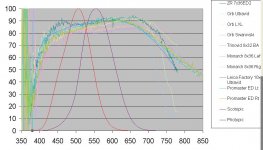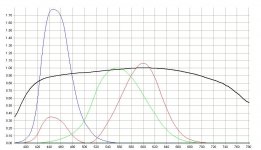John Russell
Well-known member
The quarterly German magazine, Vögel (Birds) has conducted a test of eleven 10x42 binoculars in 3 consecutive issues and I will try to summarize the results of 14 pages briefly here.
Tests were carried out in the laboratories of Leica, Minox and Zeiss and the tabulated results together with a test of the Swarovski EL Swarovision (which was not available at the start) are due to be published in December.
I will try to provide an update then.
Transmission curves for each bin were provided and as I do not have the means to scan these, I will give the results for 470 nm (blue), 670 nm (red) and the maximum value.
CANON 10x42 L IS WP
Wide FOV and excellent sharpness and contrast to edges. Low CA and least scatter of all test candidates. Excellent functioning of image stabilizer. Tripod thread and filter threads. Weight > 1 kg, eyecups too large when used without glasses.
470 nm: 80%, 670 nm: 85%, max: 87% but 85% between 490 nm and 670 nm.
KOWA XD PROMINAR 10,5x44
Lowest CA in test but lowest transmission. AFOV > 65°, highest in test but eye relief possibly critical for glasses wearers and eyecups too large for use without glasses. Focussing on test example imprecise. Filter threads and good accessories. Weight almost 1 kg.
470 nm: 77%, 670 nm: 75%, max: 83% @ 600 nm.
LEICA ULTRAVID 10x42 HD
Very good contrast with brilliant colours due to low scatter. Sharpness decreases towards edges due to field curvature rather than astigmatism. Pincussion distortion somewhat less than Zeiss FL and old Swarovski EL. Despite lower transmission than Zeiss, Swarovski and Nikon the twilight performance did not suffer due to the good contrast. Excellent finish and mechanics.
470 nm: 82%, 670 nm: 83%, max: 90% @ 610 nm.
LEUPOLD GOLDEN RING 10x42 HD
Contrast amongst the best. Warm colours but not yellowish. CA low with centered pupils but apparent when decentered. Wide FOV and only moderate fall-off in sharpness towards edges. Transmission below average and critical eye-relief for glasses wearers. Close focus 1,6 m. Poor diopter adjustment as with Kowa. Filter threads and lockable hinge. Good accessories and lifelong guarantee.
470 nm: 73%, 670 nm: 80%, max: 85% between 580 nm and 630 nm.
MEOPTA MEOSTAR B1 10x42
Resolution in right barrel average but very good 3,5" in left barrel. Good AFOV and low fall-off in sharpness towards edges. Low scatter and low CA (extra low dispersion glass?). High maximum transmission but low blue transmission leading to yellow tone. Compact dimensions but focussing wheel rubs on armouring. Poor rainguard and objective covers. Lowest price and best value for money in test.
470 nm: 77%, 670 nm: 87%, max: 91% between 600 nm and 650 nm.
MINOX APO HG 10x43 BR ASPH.
Wide FOV and good contrast. Natural and brilliant colours. Low CA, compact and light. Distance scale on focussing wheel and quick focus at short distances. Oppulent presentation box but case too small and no objective covers.
470 nm: 78%, 670 nm: 78%, max: 85% between 540 nm and 630 nm.
NIKON 10x42 HG L DCF
Relatively bright and good contrast of greens and browns. Good eye relief but narrow FOV. Low pincussion distortion and excellent edge sharpness. Best collimation in test but pronounced CA. Fast focusssing (1/5 turn for 10 m to infinity).
470 nm: 83%, 670 nm: 86%, max: 91% @ 610 nm.
NIKON 10x42 SE CF
Very bright with natural colours. Former due to lack of mirrored surfaces and fewer air/glass surfaces (external focussing). Wider FOV than HG-L and relatively low CA. Resolution in both barrels 3,5", close to Leica/Swarovski/Zeiss. Close focus 4 m. Eye relief 17 mm but rubber eyecups possibly too short for non-glasses wearers. Nikon invented twist-up eyecups - why not on this model? Not waterproof and objective covers cannot be attached to bin.
470 nm: 85%, 670 nm: 88%, max: 91% from 600 nm to 650 nm.
PENTAX DCF ED 10x43
Contrast high, resolution low. Close focus < 2 m. Narrowest FOV. Low CA but effective aperture < 40 mm. Worst collimation in test. Light and compact (similar to Minox). Why no water-repellent coatings, when the cheaper SP series has them? Mechanics stiff at low temperatures.
470 nm: 78%, 670 nm: 83%, max: 87% @ 610 nm.
SWAROVSKI EL 10x42 WB (old model)
Bright and sharp but colours less intense than some competitors with very high contrast. Nevertheless very natural due to exemplary transmission. Excellent resolution on a par with Swarovision. Better edge sharpness than Leica and Zeiss but more scatter than these two. Pronounced pincussion distortion and noticeable CA. Limited eye relief. Good case.
670 nm: 76% but in excess of 85% from 460 nm to 650 nm, max: 88%.
ZEISS VICTORY 10x42 T* FL
Best resolution together with both Swarovski bins. Unsurpassed correction of aberrations in the center enabling recognition of details which could not be seen in some other bins (use of tripler). Reflections from roof edge were undetectable. Optimized for highest transmission where the human eye is most sensitive in daytime (green /yellow, 555 nm) and hence light green bias. Ribbed armouring good for use with gloves but may not appeal without.
470 nm: 85%, 670 nm: 76%, max : 94% @ 560 nm.
To be continued.
John
Tests were carried out in the laboratories of Leica, Minox and Zeiss and the tabulated results together with a test of the Swarovski EL Swarovision (which was not available at the start) are due to be published in December.
I will try to provide an update then.
Transmission curves for each bin were provided and as I do not have the means to scan these, I will give the results for 470 nm (blue), 670 nm (red) and the maximum value.
CANON 10x42 L IS WP
Wide FOV and excellent sharpness and contrast to edges. Low CA and least scatter of all test candidates. Excellent functioning of image stabilizer. Tripod thread and filter threads. Weight > 1 kg, eyecups too large when used without glasses.
470 nm: 80%, 670 nm: 85%, max: 87% but 85% between 490 nm and 670 nm.
KOWA XD PROMINAR 10,5x44
Lowest CA in test but lowest transmission. AFOV > 65°, highest in test but eye relief possibly critical for glasses wearers and eyecups too large for use without glasses. Focussing on test example imprecise. Filter threads and good accessories. Weight almost 1 kg.
470 nm: 77%, 670 nm: 75%, max: 83% @ 600 nm.
LEICA ULTRAVID 10x42 HD
Very good contrast with brilliant colours due to low scatter. Sharpness decreases towards edges due to field curvature rather than astigmatism. Pincussion distortion somewhat less than Zeiss FL and old Swarovski EL. Despite lower transmission than Zeiss, Swarovski and Nikon the twilight performance did not suffer due to the good contrast. Excellent finish and mechanics.
470 nm: 82%, 670 nm: 83%, max: 90% @ 610 nm.
LEUPOLD GOLDEN RING 10x42 HD
Contrast amongst the best. Warm colours but not yellowish. CA low with centered pupils but apparent when decentered. Wide FOV and only moderate fall-off in sharpness towards edges. Transmission below average and critical eye-relief for glasses wearers. Close focus 1,6 m. Poor diopter adjustment as with Kowa. Filter threads and lockable hinge. Good accessories and lifelong guarantee.
470 nm: 73%, 670 nm: 80%, max: 85% between 580 nm and 630 nm.
MEOPTA MEOSTAR B1 10x42
Resolution in right barrel average but very good 3,5" in left barrel. Good AFOV and low fall-off in sharpness towards edges. Low scatter and low CA (extra low dispersion glass?). High maximum transmission but low blue transmission leading to yellow tone. Compact dimensions but focussing wheel rubs on armouring. Poor rainguard and objective covers. Lowest price and best value for money in test.
470 nm: 77%, 670 nm: 87%, max: 91% between 600 nm and 650 nm.
MINOX APO HG 10x43 BR ASPH.
Wide FOV and good contrast. Natural and brilliant colours. Low CA, compact and light. Distance scale on focussing wheel and quick focus at short distances. Oppulent presentation box but case too small and no objective covers.
470 nm: 78%, 670 nm: 78%, max: 85% between 540 nm and 630 nm.
NIKON 10x42 HG L DCF
Relatively bright and good contrast of greens and browns. Good eye relief but narrow FOV. Low pincussion distortion and excellent edge sharpness. Best collimation in test but pronounced CA. Fast focusssing (1/5 turn for 10 m to infinity).
470 nm: 83%, 670 nm: 86%, max: 91% @ 610 nm.
NIKON 10x42 SE CF
Very bright with natural colours. Former due to lack of mirrored surfaces and fewer air/glass surfaces (external focussing). Wider FOV than HG-L and relatively low CA. Resolution in both barrels 3,5", close to Leica/Swarovski/Zeiss. Close focus 4 m. Eye relief 17 mm but rubber eyecups possibly too short for non-glasses wearers. Nikon invented twist-up eyecups - why not on this model? Not waterproof and objective covers cannot be attached to bin.
470 nm: 85%, 670 nm: 88%, max: 91% from 600 nm to 650 nm.
PENTAX DCF ED 10x43
Contrast high, resolution low. Close focus < 2 m. Narrowest FOV. Low CA but effective aperture < 40 mm. Worst collimation in test. Light and compact (similar to Minox). Why no water-repellent coatings, when the cheaper SP series has them? Mechanics stiff at low temperatures.
470 nm: 78%, 670 nm: 83%, max: 87% @ 610 nm.
SWAROVSKI EL 10x42 WB (old model)
Bright and sharp but colours less intense than some competitors with very high contrast. Nevertheless very natural due to exemplary transmission. Excellent resolution on a par with Swarovision. Better edge sharpness than Leica and Zeiss but more scatter than these two. Pronounced pincussion distortion and noticeable CA. Limited eye relief. Good case.
670 nm: 76% but in excess of 85% from 460 nm to 650 nm, max: 88%.
ZEISS VICTORY 10x42 T* FL
Best resolution together with both Swarovski bins. Unsurpassed correction of aberrations in the center enabling recognition of details which could not be seen in some other bins (use of tripler). Reflections from roof edge were undetectable. Optimized for highest transmission where the human eye is most sensitive in daytime (green /yellow, 555 nm) and hence light green bias. Ribbed armouring good for use with gloves but may not appeal without.
470 nm: 85%, 670 nm: 76%, max : 94% @ 560 nm.
To be continued.
John






